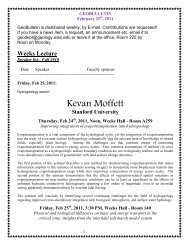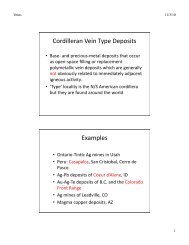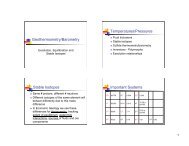Electron microprobe dating of monazite
Electron microprobe dating of monazite
Electron microprobe dating of monazite
You also want an ePaper? Increase the reach of your titles
YUMPU automatically turns print PDFs into web optimized ePapers that Google loves.
5(I .I,-M. Montel el aL / Chentical Geology 131 (1990) 37-53<br />
5.6. Future work<br />
This method is in the early stages <strong>of</strong> its develop-<br />
ment. Because its field <strong>of</strong> application is large, and<br />
because it can easily be set up on any electron<br />
<strong>microprobe</strong>, we predict that it will become a rou-<br />
tinely and widely used technique. It will make in-situ<br />
<strong>dating</strong> accessible to a large population <strong>of</strong> geologists.<br />
and numerous new results will be obtained, in partic-<br />
ular for old cratons. The method can certainly be<br />
improved, in particular by other laboratories equipped<br />
with a more up-to-date machine. We think that it is<br />
possible to use probe currents as high as 300 nA,<br />
without damaging <strong>monazite</strong>, in order to get better<br />
precision and a lower detection limit. Progress can<br />
be made too by analysing elements other than U. Th,<br />
Pb, such as those with low atomic number (Si, Ca, P.<br />
Y), to obtain a more rigorous matrix effect correc-<br />
tion. As modem <strong>microprobe</strong>s have very elaborate<br />
mapping abilities, it is possible also to make age<br />
maps in crystals and this will give a lot <strong>of</strong> informa-<br />
tion on the behaviour <strong>of</strong> the U-Th-Pb system in<br />
<strong>monazite</strong> at the crystal scale (Suzuki et al., 1994).<br />
Finally, the best results will be obtained by combin-<br />
ing the chemical data from the electron probe, and<br />
the isotopic data obtained with an ion probe.<br />
Acknowledgements<br />
We would like to thank very much all the people<br />
who kindly provided us with samples <strong>of</strong> various age,<br />
in particular Bob Trumbull, Francois Gibert, Bernard<br />
Charoy, Patrick Le Fort, Jean-Michel Bertrand, and<br />
Franck Desgrolard. Special thanks to Tim Druitt for<br />
correcting the English language. Fair and construc-<br />
tive <strong>of</strong>ficial reviews by T.M. Harrison and S.J.B.<br />
Reed have been greatly appreciated.<br />
Appendix A. Least-squares modelling <strong>of</strong> multiple<br />
ages<br />
A <strong>microprobe</strong> age T~ is obtained through an ana-<br />
lytical procedure which introduces a random error<br />
8oi = T i - tel. At this stage the exact value tel is not<br />
implied to represent a true geological age, but just<br />
the translation into time units <strong>of</strong> an exact chemical<br />
quantity, the Pb-Th-U proportions. The error 80i is<br />
generated from a probability distribution .~(8), e.g.<br />
the Gaussian:<br />
1 exp[ '(6/CrT,) 2] (A-I)<br />
The most likely estimates <strong>of</strong> toi (t i) are obtained<br />
by maximizing the joint probability distribution:<br />
t'(l I .t,. _ ... ,t,,) = I-If,(i-t,) pl T<br />
i-I<br />
(A-Z)<br />
subject to the constraint that:<br />
"t~. t: ..... t,, verily the proposed model (exactly)"<br />
(A-3)<br />
This formulation is just classical quantitative mod-<br />
elling, and would apply to any kind <strong>of</strong> data and any<br />
kind <strong>of</strong> theory. For Gaussian errors, maximizing Eq.<br />
A-2 is equivalent to minimizing:<br />
~1 Ti _ t i ]-<br />
S-- E , (A-4)<br />
i = I O'T, ]<br />
and the simplest theory that could apply to the<br />
<strong>microprobe</strong> ages is that all domains have evolved in<br />
closed system since some geological event <strong>of</strong> age a:<br />
t--a=O Vie[1,n] (A-5)<br />
Minimizing Eq. A-4 subject to Eq. A-5 leads to<br />
the well-known weighted mean:<br />
a -<br />
it ~t<br />
Y'; ,T/<br />
I (A-6a)<br />
i=l O'7~<br />
1<br />
cr - (A-6b)<br />
l'= 6rJ~<br />
The next simplest theory is that some domains<br />
record a geological event <strong>of</strong> age a, and others (e.g.,<br />
from inherited cores) another event <strong>of</strong> age b. Eq.<br />
A-5 should then be replaced by:<br />
(t,-a)(t,-b)=O Vie [l,n] (A-7)<br />
and so forth for (m > 2) age components, if neces-<br />
sary.





